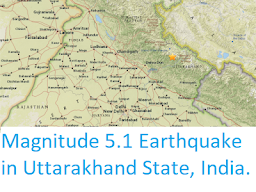Three roadworkers have died following a landslide on the Rishikesh-Badrinath stretch of National Highway 58, near Bayasi in Tehri Garhwal District, Uttarakhand, on Monday 24 August 2020. The incident happened at about 5.30 am local time, where the men were involved in clearing debris from an earlier landslide at the same location, caused by heavy rainfall in the same area, which is believed to have been caused by several days of heavy rain associated with the annual monsoon. Landslides are a common problem after severe weather events, as excess pore water pressure can overcome cohesion in soil and sediments, allowing them to flow like liquids. Approximately 90% of all landslides are caused by heavy rainfall. The men have been identified as Prabhat, 32, Sanjeev Kumar, 40, and Rajesh; all are believed to have come from Punjab. The landslide swept the men and the equipment they were operating from the road, which is raised some way above the waters of the River Ganges, currently in flood.
Monsoons
are tropical sea breezes triggered by heating of the land during the
warmer part of the year (summer). Both the land and sea are warmed by
the Sun, but the land has a lower ability to absorb heat, radiating it
back so that the air above landmasses becomes significantly warmer than
that over the sea, causing the air above the land to rise and drawing in
water from over the sea; since this has also been warmed it carries a
high evaporated water content, and brings with it heavy rainfall. In the
tropical dry season the situation is reversed, as the air over the land
cools more rapidly with the seasons, leading to warmer air over the
sea, and thus breezes moving from the shore to the sea (where air is
rising more rapidly) and a drying of the climate. This situation is
particularly intense in South Asia, due to the presence of the
Himalayas. High mountain ranges tend to force winds hitting them
upwards, which amplifies the South Asian Summer Monsoon, with higher
winds leading to more upward air movement, thus drawing in further air
from the sea.
See also...


Follow Sciency Thoughts on Facebook.





